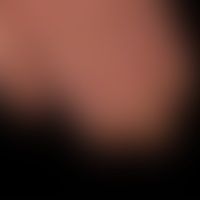Image diagnoses for "Nail"
60 results with 303 images
Results forNail

Lichen planus (overview) L43.-
Lichen planus verrucosus: red plaque with an irregular surface relief; the livid-red colour of Lichen planus is clearly visible at the edges.

Melanoma cutaneous C43.-
Melanonychia longitudinalis: stripy (melanotic) nail pigmentation caused by a (still benign) pigment nevus localized in the (not visible) nail matrix. The anterior incision edge of the nail plate is pigment-bearing (marked with an arrow). An initial malignant melanoma must be excluded.

Melanoma acrolentiginous C43.7 / C43.7
melanoma, malignant, acrolentiginous. reddish, partly skin-coloured, slowly growing, coarse plaque, which has predominantly displaced the nail bed. there are also bizarre, black-brown hyperpigmentations. the nail plate is no longer existent except for a rest.

Melanoma acrolentiginous C43.7 / C43.7
DD: Melanoma malignant acrolentiginous melanoma; here: complicating onychomycosiswith bleeding after banal trauma.

Melanoma acrolentiginous C43.7 / C43.7
DD: acrolentiginous malignant melanoma: here: Melanonychia longitudinalis:stripy (melanotic) nail pigmentation caused by a (still benign) pigment nevus localized in the (not visible) nail matrix. The anterior cut edge of the nail plate is pigment-bearing (marked with an arrow). An initial malignant melanomacan be excluded histologically with certainty.

Melanoma acrolentiginous C43.7 / C43.7
DD. acrolentiginous malignant melanoma: in this case nail hematoma . 6 weeks old (trauma recall), sharp blue-black discoloration of the big toe nail (marked by arrows and line) with discoloration of the epinychium (circle). arrow (right) indicates a streaky (still red) apparently fresh bleeding.

Melanonychia striata L60.8
Melanonychia striata longitudinalis (course): Initial findings in 2006, control findings 3 years later; the brown longitudinal stripe, persisting since about 2004, has almost completely receded within a period of 3 years except for a discrete residual pigmentation (arrow).

Melanonychia striata L60.8
Melanonychia striata longitudinalis. incident light microscopy: Melanonychia striata through melanocytic nevus on the index finger in a 19-year-old woman. fine-grained longitudinal brown pigmentation below the nail plate. normal nail fold capillaries. distinct pigmentation of the cuticles.

Melanonychia striata L60.8
Melanonychia striata longitudinalis: No pimentation of the perionychium = negative Hutchinson sign.

Melanonychia striata L60.8
Melanonychia striata longitudinalis. approx. 2 mm wide, light brown stripe in the region of the thumbnail in a 7-year-old boy. No involvement of the nail fold, no paraungual border. Currently harmless findings.

Onychomycosis (overview) B35.1
tinea unguium: black dyschromia of the nail plate localized at the left big toe of a 52-year-old man, increasing for more than one year. border zone to the healthy nail plate marked proximally by a horizontal arrow. cuticle not discolored (vertical arrows: speaks against a melanocytic tumor). nail plate itself is discolored (see anterior incision margin marked by a star). Trichophyton rubrum and Aspergillus spp. have been culturally proven.

Onychomycosis (overview) B35.1
Tinea unguium: distalsubungual discoloration in fungal infection; the nail matrix is crumbled under the surface and can be easily removed with a cleaning instrument.

Onychomycosis (overview) B35.1
Distal onychomycosis with crumbly destruction of the nail matrix; discrete, aphlegmatic tinea of the finger skin with slight scaling.

Trachyonychia L60.8
Trachyonychia: rough, lackluster, otherwise symptom-free nail surfaces in Alopecia areata totalis.

Nail pitting due to psoriasis L60.8
Spotted nails: pronounced pit-shaped nail dystrophies (so-called spotting) in known psoriasis.

Splinter hemorrhages
Splinter hemorrhage: Reflected light microscopic image with a few days old splinter hemorrhage.

Pincers-nail L60.3
Pincer-nails: systemic scleroderma with continuous formation of pincer-nails, which are now painful under firm pressure.

Nail hematoma T14.05
Nail hematoma: direct comparison of the outgrowing nail hematoma. Lower left after 8 weeks. On the right the reflected light microscopic images.

Nail hematoma T14.05
Hematoma, nail hematoma: growing nail hematoma . left initial situation, right 8 weeks later. note: the nail matrix shows no discoloration at the cutting edge (marked by arrows)!

Paronychia chronic L03.0
chronic paronychia: paronychia existing for months, with massive onychodystrophy. only slight painfulness. candida albicans was detected several times.

Paronychia chronic L03.0
Paronychia chronic: chronic Candida paronychia. pat. with constant wet work.

Paronychia chronic L03.0
chronic paronychia: existing for months (physiological growth of the fingernail about 0.10 to 0.12 mm per day), slightly painful paronychia with growth disturbances of the nails. nail fold (encircled) reddened and swollen. moderate pain under pressure. from time to time a purulent secretion empties under pressure. cuticles completely missing.

Onychogrypose L60.2
Onychogrypose in psoriasis: completely changed growth direction of the big toe nail, now only vertically oriented.

